Do you have an interest in current events? Do you want to share your perspective on the latest news stories with the world?
Starting a news blog is a great way to do just that! In this post, we’ll teach you how to start a news blog in 2025 and make money online. You will learn everything you need to know from choosing a platform to creating content.
If you have any questions along the way, just drop a comment and I will help you out.
So let us jump right in.

How to Start a News Blog in 7 Steps
- Define Your News Blogging Goals
- Choose a News Niche
- Pick & Register a Blog Domain Name
- Setup WordPress
- Write & Publish Blog Posts
- Promote Your News Blog
- Monetize & Make Money
1. Define Your News Blogging Goals
The first step to starting a news blog is to figure out what your goals are. What is the purpose of your blog?
- Are you trying to inform people about current events?
- Do you want to share your opinion on the latest news stories?
- Do you want to make money?
Whatever your goal is, you must have a clear understanding of what you want to achieve with your blog. This will help you determine everything from the name of your blog to the types of content you publish.
If you’re not sure what your goals are, here are some questions to ask yourself:
- What topics am I passionate about?
- What points of view do I want to share?
- What do I want people to take away from my blog?
- What can I offer that is unique or different from other news blogs?
- Do I want to focus on local, national, or international news?
- What type of tone do I want my blog to have?
What is a News Blog?
A news blog is a blog that shares news, thoughts and opinions on current events. A news blog can be about any topic, from politics to sports to pop culture. There are many different types of news blogs, but they all have one common goal: to engage readers in a discussion about the latest news stories.
Why Start a News Blog?
There are many reasons why you might want to start a news blog. Maybe you’re passionate about a particular topic and you want to share your perspective with the world. Or maybe you’re looking for a way to make money online.
No matter what your reason is, starting a news blog can be a great way to achieve your goals.
The benefits of starting a news blog include:
- You can share your opinions and engage in discussion with other like-minded people.
- You can build a platform to share your ideas with the world.
- You can connect with other bloggers and create a community.
- You can make money through advertising, affiliate marketing, or selling products and services.
How much money can you make from news blogging?
You can make $15-$25 for every 1000 ad views on your news blog. An SEO optimized blog post can get anywhere between 300 to 1000 visits per month. So, a news blog with 100 blog posts can make as high as $2500 every month. You can make even more money if you monetize with affiliate marketing and digital products.
2. Choose a News Niche
Now that you know what your goals are, it’s time to choose a niche.
Your niche is the specific topic or angle that you will be covering on your blog. For example, if you’re passionate about politics, your niche could be political commentary. If you’re interested in sports, your niche could be sports journalism.
Why choose a niche?
Choosing a niche is important for two reasons. First, it will help you focus your content and make your blog more cohesive. Second, it will help you attract readers who are interested in the same topics as you are.
For example, let’s say you’re passionate about politics and you want to start a news website about it.
If you choose a general niche like “politics,” your blog will be competing with millions of other blogs that cover the same topic. But if you choose a specific niche like “political commentary,” your blog will be much easier to find for people who are interested in that topic.
And when people can easily find your blog, they’re more likely to become regular readers.
Finding Your Ideal Niche
Finding your niche is all about figuring out what you’re passionate about and what you have to offer that is unique or different from other news blogs. When choosing a niche, it’s important to consider your interests, expertise, and goals.
Here are some questions to ask yourself when finding your niche:
- What topics am I passionate about?
- What points of view do I want to share?
- What do I want people to take away from my blog?
- What can I offer that is unique or different from other news blogs?
- Do I want to focus on local, national, or international news?
- What type of tone do I want my blog to have?

Here are a few news niches to help you find yours:
- Politics
- Sports
- Science
- Entertainment
- Pop culture
- Technology
- Business
- Fashion
Come up with a few niche ideas.
Examples of News Blogs
Sometimes looking at other news blogs will help inspire ideas of your own. Here are some of the more popular examples of news blogs:
1. Engadget
The blog started as a review blog for the latest gadgets and consumer electronics. But it has grown into a tech news blog.

2. Science Daily
This blog covers the latest news in all fields of science.

3. Perez Hilton
The blog covers celebrity news, gossip, scandals, and fashion. They also cover the latest reality shows.

4. Glamour
The blog covers fashion news, tips, and guides for women.

5. Deadspin
The blog offers sports news and opinions. They also cover the more controversial side of sports.

3. Pick & Register a Blog Domain Name
Once you have chosen your niche, it is time to brainstorm a few names for your news blog.
We recommend you keep your news blog’s name to two words (Example: Science Daily). One of the two words should be a keyword from your niche. The other word can be something that makes your blog brandable. For example, our blog teaches people how to make passive income, so we have named it Passive Book.
Here are some of the words that you can mix and match into your blog name:
- Daily
- Times
- News
- Wire
- Journal
- Today
- Express
- Post
- Press
- Media
Use a Business Name Generator to brainstorm the name of your blog.
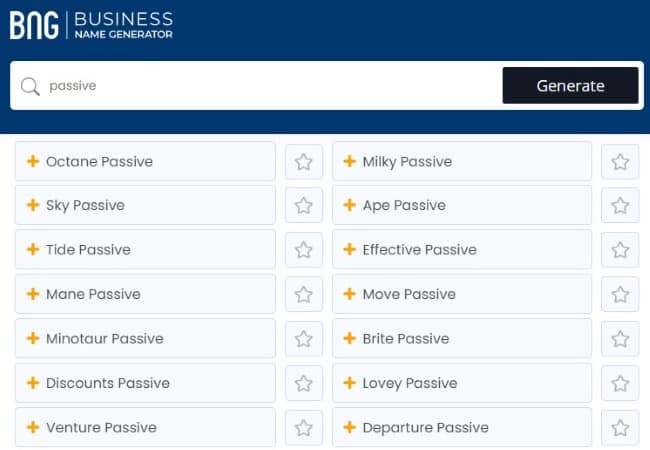
You can also use your own name for your blog. But if you ever plan to sell your blog in the future, it is much more difficult to transfer your brand to the buyer when it is your name.
Check Domain Name Availability
After you have brainstormed a few names for your news blog, you should check if the .com domain name is available.
Your domain name is the web address people will use to find your blog (for example, www.yourdomainname.com). It is usually your blog name followed by your domain.
You must check if both the .com domain name and the social media handles are available. You can use Namechk to check the availability of both your domain name and social media handles.
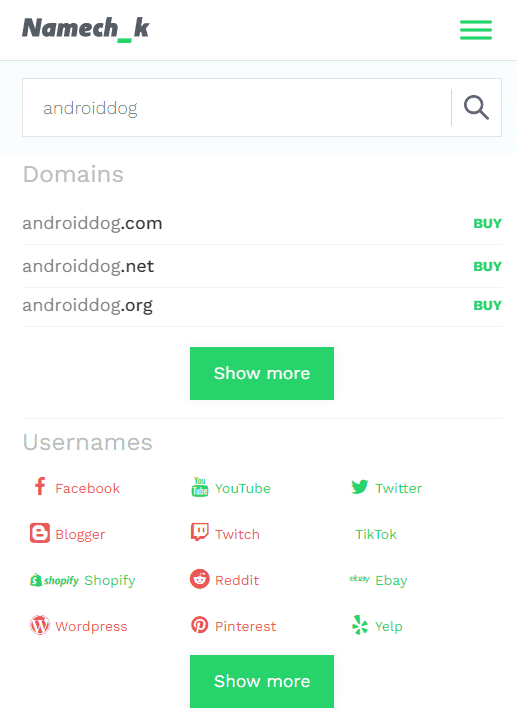
Here are a few things to keep in mind when selecting a domain name:
- Choose a .com domain name. 86% of the internet uses .com, so your visitors are likely to try visiting your blog by typing .com. Avoid other extensions like .net or .org.
- Don’t include hyphens and numbers.
- Do not use words with multiple spellings (for example colour vs color).
- Shorter domain names are better. Try to keep it under 12 characters.
- Spelling & Pronunciation should be easy and intuitive.
- It should be easy to remember.
- Avoid words that can be misread together. For example, therapistjohn.com can be read as Therapist John or The Rapist John.
- Make sure it’s not trademarked or copyrighted by someone else. The AI writing software Jarvis.ai had to rebrand to Jasper.ai because Marvel sued them for the Iron Man reference. Lawsuits will happen once your blog is established.

Register a Domain Name
Once you decide your domain name it is time to register it.
You should register your domain with NameCheap because you will get domain privacy for free. Other providers charge $12 per year for domain privacy. Without domain privacy, your name, home & email address will be accessible to the public.
Step 1: Go to NameCheap. Enter your domain name with the .com extension.

Step 2: Select the .com extension and click the Add to Cart button.
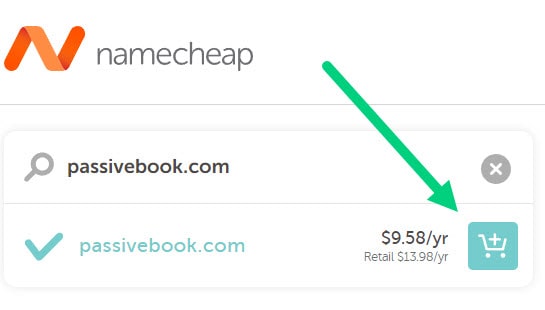
Step 3: After adding the domain to the cart, click on the Checkout button.
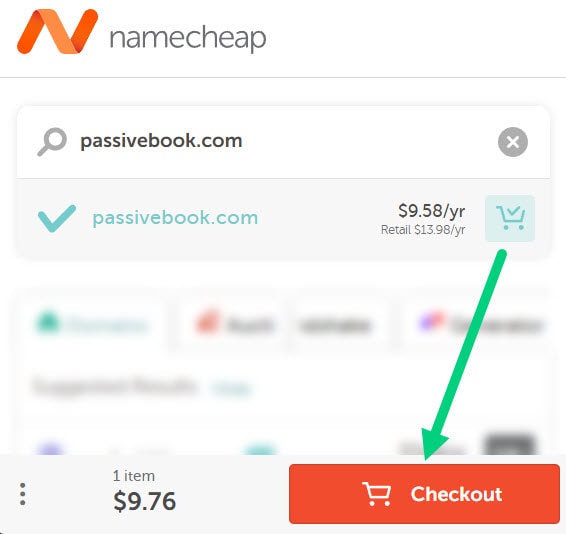
Step 4: Enable Domain Privacy that comes for free along with auto-renew. You don’t need any other paid addon.
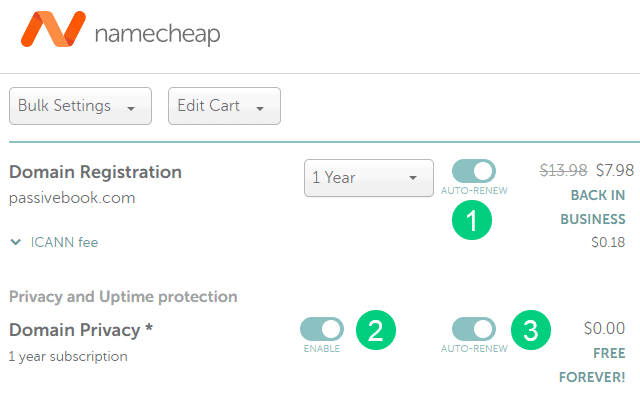
Step 5: Click on Confirm Order. Pay to complete your purchase.
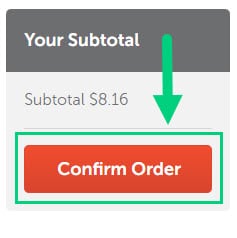
Step 6: Log in to Namecheap and click on Domain List ❶ in the left sidebar and then click Manage ❷ next to the domain you just purchased.
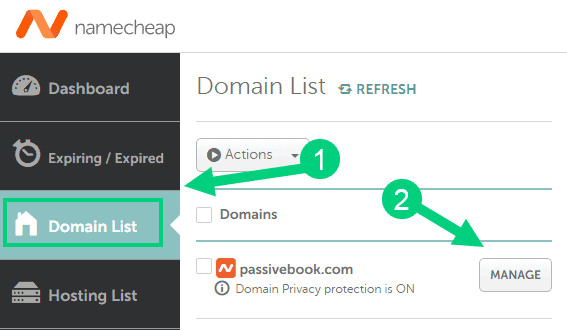
Step 7: Under the Nameservers section, select “Custom DNS” from the dropdown ❶. Then enter the following two nameservers ❷ ns1.bluehost.com and ns2.bluehost.com as shown in the image. Then click the green tick ❸ to save. If you use a hosting provider other than Bluehost, enter their nameserver values in this step instead.
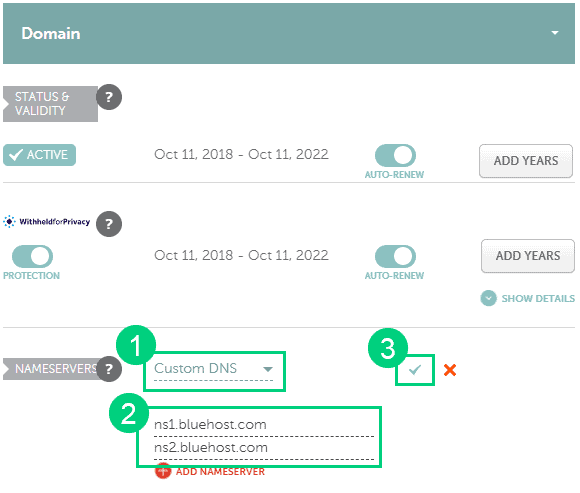
Can I get a free domain name?
Your web hosting provider might give you a free domain name for one year but they charge $12 for domain privacy which is free in Namecheap. From the second year, you will pay for both the domain and privacy which will cost you more than $20+. So it is cheaper to just register your domain with Namecheap from the beginning. Also using different companies for web hosting and domain registration will allow you to easily switch your blog host later without transferring domains.
Can I change the name of my blog later?
You will lose your search engine rankings if you change your blog’s name once it gets links from other websites. It will take as long as a year or more for you to regain the lost traffic. It is possible to mitigate problems by having proper redirects. But you will have to renew both your old and new domains every year. So try to avoid changing your blog’s name once it is established.
4. Setup WordPress
Now that you have your domain name and hosting account, it is time to set up WordPress. WordPress is a content management system (CMS) that makes it extremely easy to have a blog without learning how to code.
Why Choose WordPress.org?
There are many blogging platforms but the self-hosted wordpress.org powers 70% of blogs on the internet. 44% of all blogs on the internet use WordPress. It is the most popular content management system because it is:

- Open Source: It is completely free and anyone can contribute to it. There are currently over 60,000 plugins available to make your blog more functional.
- Self Hosted: You will need to buy hosting and a domain name to use WordPress.org. But this also means you have complete control and ownership of your content.
- Beginner Friendly: It is extremely user-friendly and easy to use. You can easily create beautiful blogs without learning how to code.
- Customizable: You can change how your blog looks by installing themes and plugins.
- SEO Friendly: WordPress makes it easy to do on page SEO so you can rank higher on search engines and get more traffic.
WordPress.org vs WordPress.com
There are two versions of WordPress – WordPress.com and WordPress.org.
- WordPress.com: is a free platform where you can create a blog without having to buy hosting or a domain name. It might seem like a good option but you cannot monetize your blog with ads and it has many other limitations such as not being able to install plugins or customize your theme.
- WordPress.org: This is the self-hosted version of WordPress that we recommend for news blogs. You will need to buy hosting and a domain name but it gives you full control over your blog. You can install plugins, customize your theme, and make money from your blog without any restrictions.
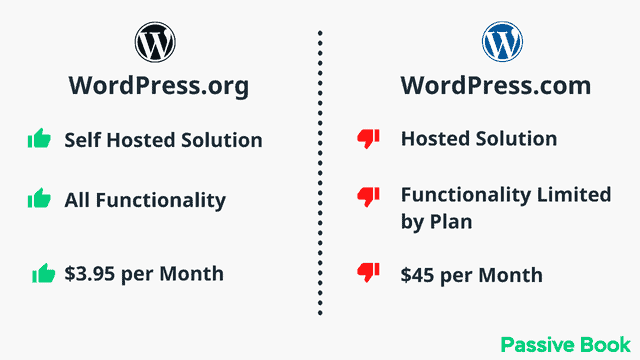
Why Avoid Free Blogging Platforms
There are many free blogging platforms such as Blogger, Tumblr, and WordPress.com. While they might seem like a good option at first, they have many limitations such as not being able to install plugins or customize your theme.
They are also not very SEO friendly which means it will be harder for people to find your blog on search engines. In addition, most of these platforms do not allow you to run ads so you cannot make money from your blog.
Your blog can be deleted by these free platforms without any way to recover it. Blogger for example deletes blog without reason.

We recommend avoiding free blogging platforms and using the self-hosted WordPress.org instead. It is extremely user-friendly, customizable, and you can make money from your blog without any restrictions.
How much does it cost to start a news blog?
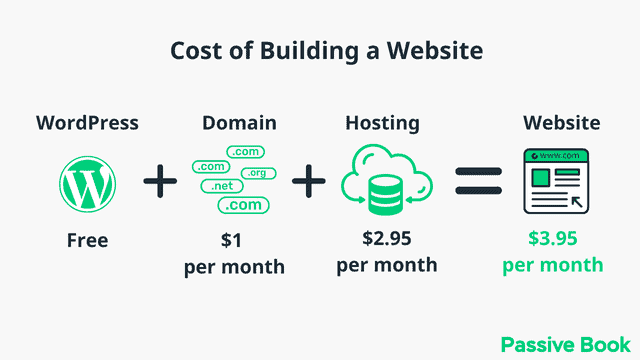
It will cost you $2.95 per month to host your WordPress news blog in BlueHost. A domain will cost you $12/year. So that is a total of $4.2 per month, which is less than the price of Netflix for all the unlimited features that a self-hosted WordPress blog has to offer.
What to do if you already have a free blog?
If you are currently using a free blogging platform such as Blogger, Tumblr, or WordPress.com, it is very easy to migrate to WordPress using the free import plugin. The import plugin will automatically copy all your posts, comments, and images from your old blog to your new WordPress blog.
Install WordPress in Hosting
Before you can install WordPress, you need to get hosting.
Blog hosting is a service that stores your blog content and makes it available on the internet. When someone enters your domain name in a browser, your hosting will load your blog post, files, and images in your visitor’s browser.
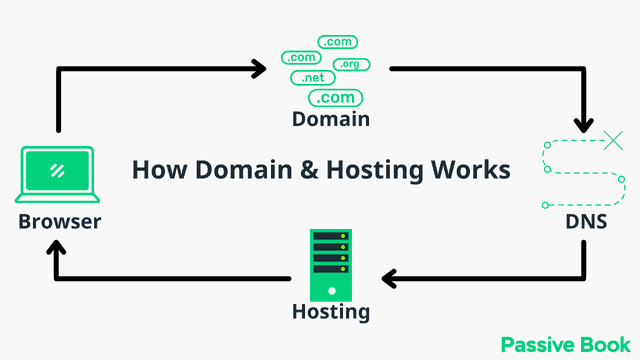
For this guide, we will use BlueHost as our web host. It is a cheap hosting that is extremely easy for beginners to set up. If you use any other web host, the steps will be the same but the user interface may be slightly different.
1. Go to BlueHost using this link to get a special discount. Select WordPress > WordPress Hosting from the top menu.
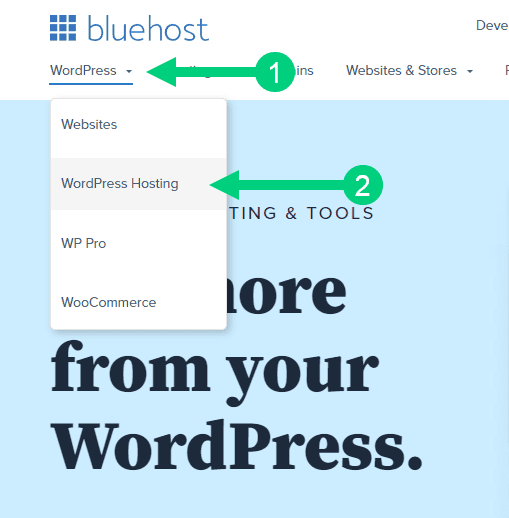
2. Click on the button you see on this page and you will be taken to the pricing section.
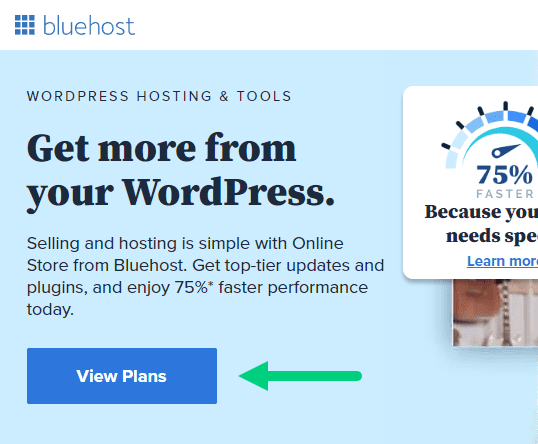
3. Select the Basic Plan. You can upgrade to a different hosting plan as you grow.

4. If you already have a domain name that you purchased with Namecheap you can put that in the “Use a domain you own” ❶ section. If you don’t have a domain name yet, choose the “Create a New Domain” ❷ to purchase a new domain.
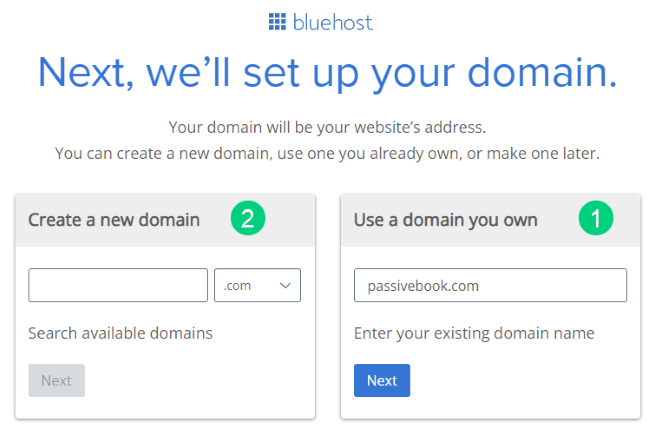
5. In the next screen, enter your information. Uncheck all package extras. If you purchase your domain through Bluehost instead of Namecheap, you may want to enable Domain Privacy. You won’t see the Domain Privacy option if you bought your domain through Namecheap. Namecheap will give you this Domain Privacy for free.
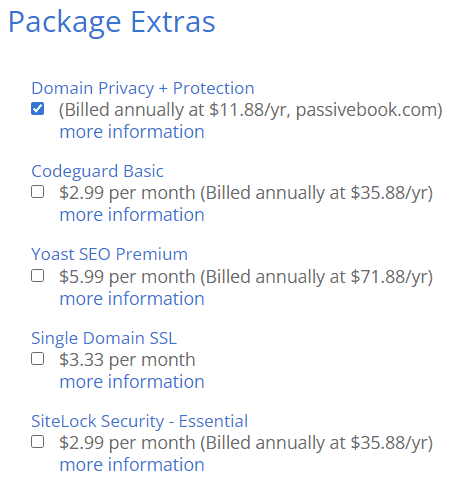
6. Once you have successfully paid, you will be prompted to set a password. Click on the “Create your Password” button.
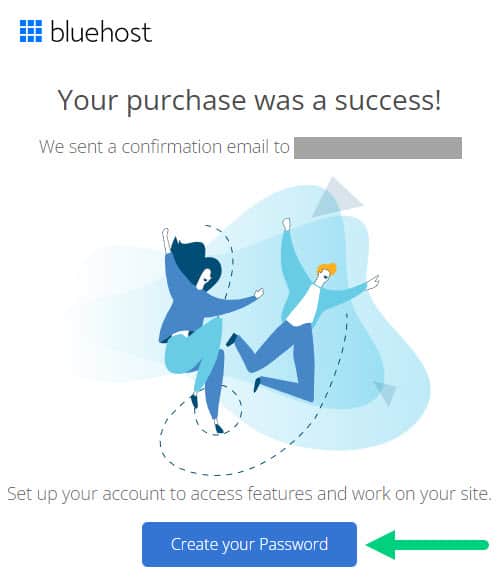
7. Enter your password and create your account. If you lose this password, you can reset it.
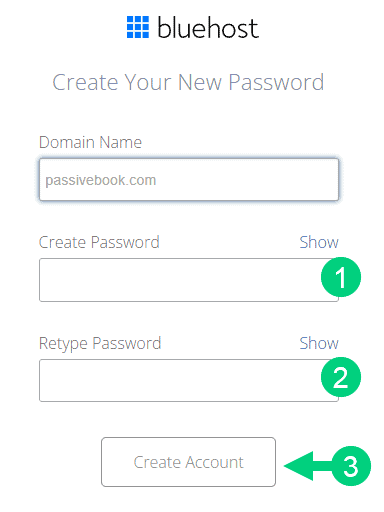
8. After you set your password, log in to Bluehost.
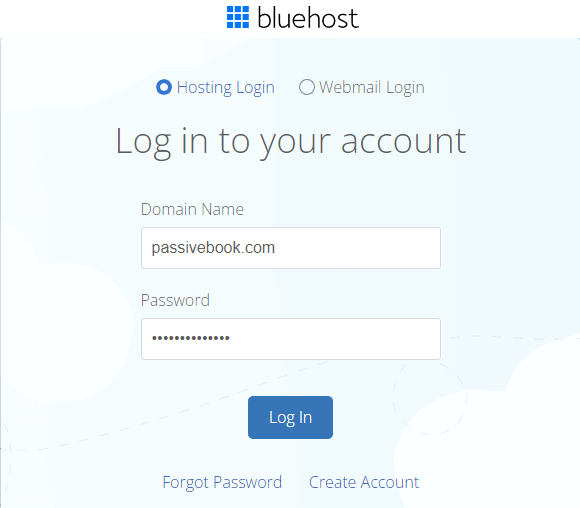
9. Click on the Create your website button on the following screen. This will start a Bluehost Wizard, just click Skip this step wherever possible.

10. On the following page, click “No help needed” or “Skip this step”. We don’t want Bluehost to limit our customization options.
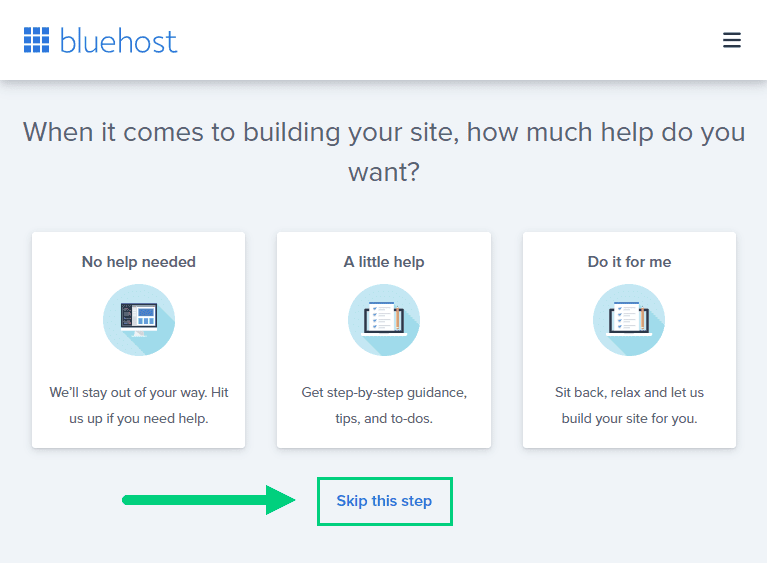
11. On the next page, you will be asked about the purpose of your website. You can choose from any of the available options.
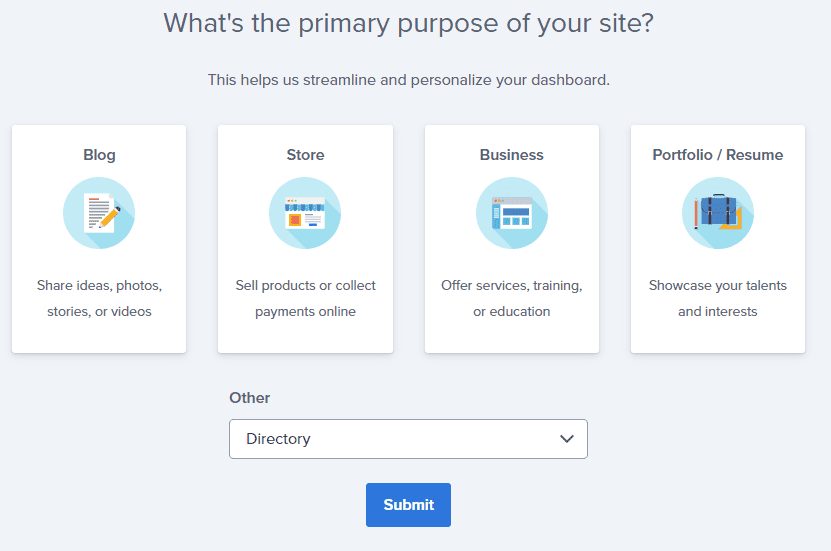
12. On the next page, click Skip this step.

13. On the following page, enter the blog’s name and tagline. You can change this later so feel free to click “Skip this step” or enter something as a placeholder and click Continue.
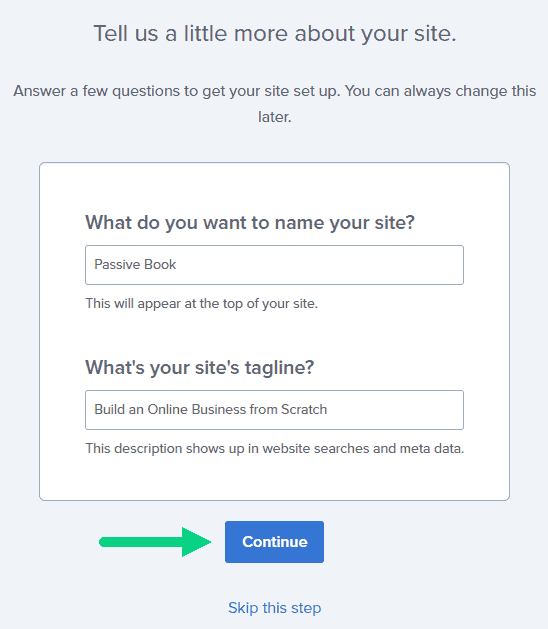
14. Finally you will be asked how you want to build your website. Choose “Limitless customization” to have all the options.

15. You can see your blog by going to yourdomain.com. Go to the Bluehost dashboard and click on the My Sites tab ❶ in the left sidebar and click on the “Manage site” button ❷.
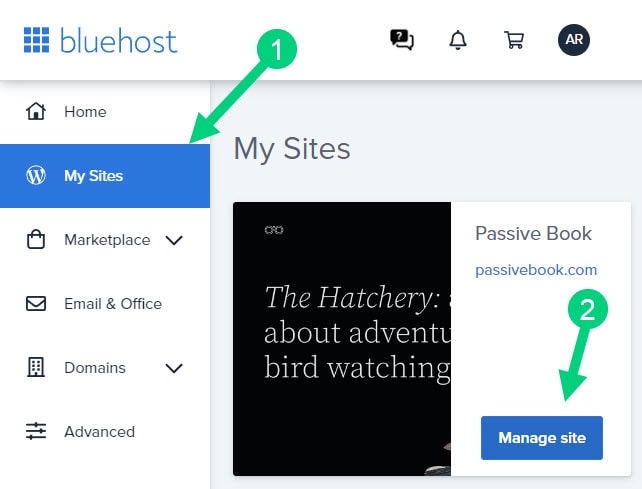
16. Your WordPress site has separate login credentials different from the ones you use to log into Bluehost. You can use this to log in to the WordPress dashboard directly without logging into Bluehost. To get this:
❶ Click on Users on top.
❷ You will be able to see your username and email that you can use to log in to WordPress.
❸ If you click on the three dots you will see the option to Reset your password. ❹
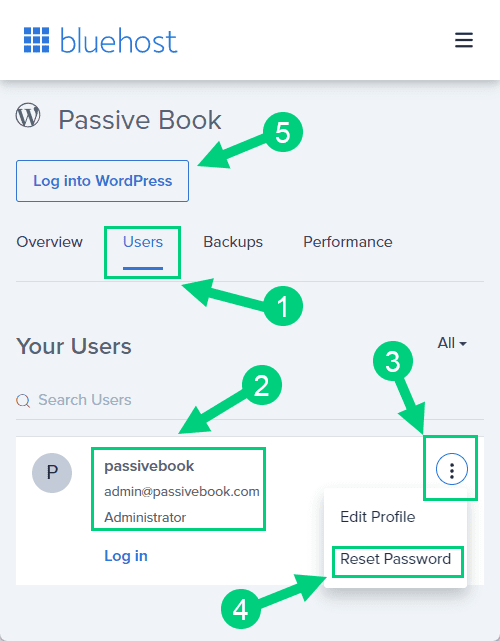
You can log into WordPress from the Bluehost dashboard by clicking the Log in to WordPress button ❺. But it is not recommended you rely on this as your primary login method because you will get locked out of your site if you ever change hosting providers.
17. You will be taken to the WordPress dashboard where you can reset your password ❶. If you don’t like the username Bluehost created for you, you can Add a New User ❷.

18. If you are adding a new user make sure you specify the user role as Administrator ❶. You can log in as the new user and safely delete the default user created by Bluehost.

Congratulations! You have successfully set up WordPress.
Configure WordPress
Now that you have the basic version of WordPress installed, it is time to customize it to make it look and feel the way you want.
Login to WordPress Dashboard
Visit yourdomain.com/wp-admin to access the WordPress dashboard.
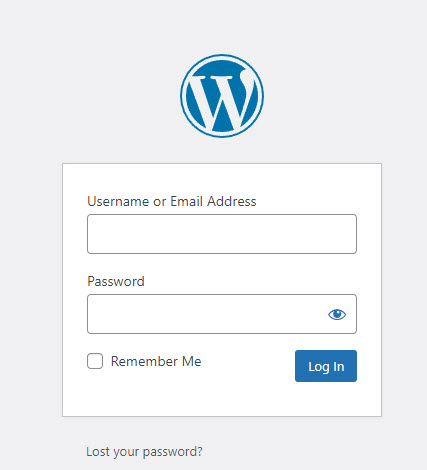
The WordPress dashboard is the control center for your blog. It includes all the tools and options you need to manage your blog.
Use the Email and Password you provided during installation to log in to your WordPress dashboard. If you don’t have a password, use the “Lost your password?” to generate a new password.
Install WP Themes
A WordPress Theme is a collection of files that tells WordPress how to display your blog. It includes the design, fonts, colors, and overall layout of your blog.
Your new WordPress blog will be installed with a default blog theme that doesn’t look very great.
To install a new WordPress Theme:
Go to Appearance > Themes > Add New in your WordPress dashboard.
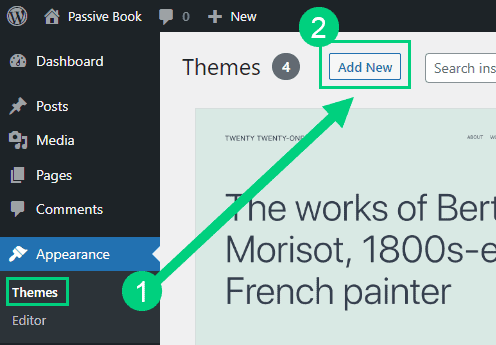
Use the search to find a theme that you like ❶. Before you install the theme, you can see a demo of the theme and learn about its features from the preview screen ❷. If you like the theme, you can install it by clicking the install button ❸. You can also upload a theme from a file on your computer ❹.

Once installed, click the Activate button to enable the theme.
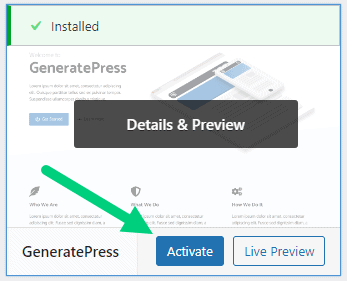
Although you can use a free theme (there are thousands of free themes available), we recommend using a premium theme.
Premium themes not only reduce your blog’s load time but also help you customize your blog to your heart’s desire.
Here are the premium themes we recommend:
There are also several custom-made news blog themes. These themes tend to be bloated with poor code which will slow down the performance of your blog. We suggest getting one of our recommended themes for a fast blog with unlimited customization possibilities.
Install WP Plugins
A WordPress Plugin is a software that adds additional features to your WordPress blog. It can be used to add a contact form, social media buttons, or even a shop to your blog.
Too many wordpress plugins can slow down your blog site. So before you install new plugins, it will be worth clearing out any existing plugins that your hosting provider installed by default.
Plugins first need to be deactivated before they can be deleted.
❶ Go to WP Admin > Plugins > Installed Plugins
❷ Click on the checkbox to select all plugins.
❸ Select Deactivate from the drop-down.
❹ Click Apply.
❺ Repeat the above steps but select “Delete” instead of “Deactivate” from the dropdown in ❸ to delete all the deactivated plugins.
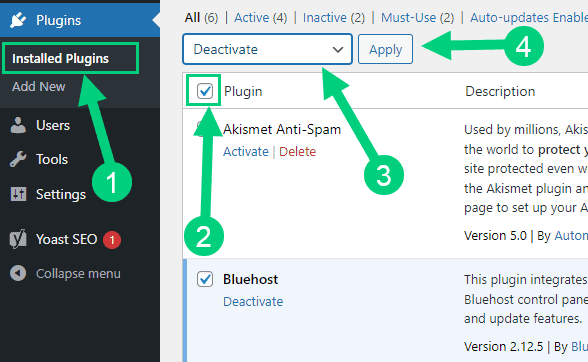
To install new plugins go to the WP Admin > Plugins > Add New.

On the plugins page:
❶ Search for the plugin you want in the search bar
❷ Click Install Now. Once you install the plugin, you must also activate the plugin for it to be enabled.
❸ If you are installing a paid plugin you can upload the plugin instead.
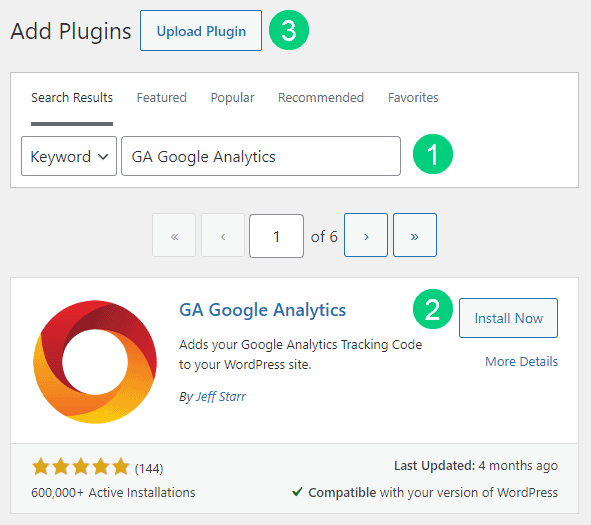
There are many different news blog plugins that you can install, but here are the ones which we recommend:
Backup Plugin: A WordPress Backup Plugin is a plugin that automatically backs up your WordPress blog. This includes your posts, comments, images, and any other files on your blog.
Backup plugins are essential because they help you easily restore your blog if something goes wrong.
Recommended Plugin: WPVivid (paid) or UpdraftPlus (free).
SEO Plugin: WordPress SEO plugins help you to optimize your blog for search engines. They can help you to improve your blog’s ranking, increase your blog’s traffic, and even increase your blog’s subscribers.
Recommended Plugin: RankMath (paid).
Google Analytics Plugin: A WordPress Google Analytics Plugin is a plugin that collects the data of your blog visitors and sends it to your Google Analytics account. This allows you to see how many people are visiting your blog, where they are coming from, and what pages they are visiting.
Recommended Plugin: RankMath (paid) or GA Google Analytics (free).
Cache Plugin: A WordPress Cache Plugin is a plugin that speeds up your blog by caching your blog’s pages and posts. This means that once the pages and posts have been loaded, they are stored on the server so that they can be accessed quickly the next time someone visits your blog.
Recommended Plugin: WP Rocket (paid).
Page Builder Plugin: A WordPress Page Builder Plugin is a plugin that allows you to easily create custom pages and posts for your blog. You can add columns, images, text, and other elements to your pages and posts without having any coding knowledge.
Recommended Plugin: Thrive Architect (paid).
Security Plugin: A WordPress Security Plugin is a plugin that helps to protect your WordPress blog from hackers and other online threats.
Some of the features that a security plugin may offer include password protection, two-factor authentication, firewall protection, malware scanning, and spam blocking.
Recommended Plugin: Wordfence (free).
Social Media Plugin: A WordPress Social Share Plugin is a plugin that allows you to easily share your blog posts on social media platforms such as Facebook, Twitter, and Instagram.
Recommended Plugin: Easy Social Share Buttons (paid).
Email List & Lead Generation Plugin: An email opt-in form plugin is a plugin that allows you to collect the email addresses of your blog visitors and sends them to your email marketing service. This allows you to build a list of subscribers and send them regular newsletters or other emails.
Recommended Plugin: Thrive Leads (paid).
Customize WordPress
Once you have installed your theme and plugins, it is time to customize the wordpress blog platform:
Change Colors, Fonts & Spacing
You can set the font, colors, and spacing by going to Appearance > Customize in your WordPress dashboard. Premium themes like GeneratePress allow you to customize every aspect of your blog.
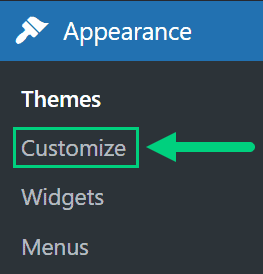
Check out our Blog Fonts & Typography guide to choose the right font and typography settings for your blog.
Add Your Logo
Get a logo designed for your blog from Fiverr. Then set the logo of your blog by going to Appearance > Customize in your WordPress dashboard. A logo is not required for a successful blog but it can definitely help appeal to your target audience.
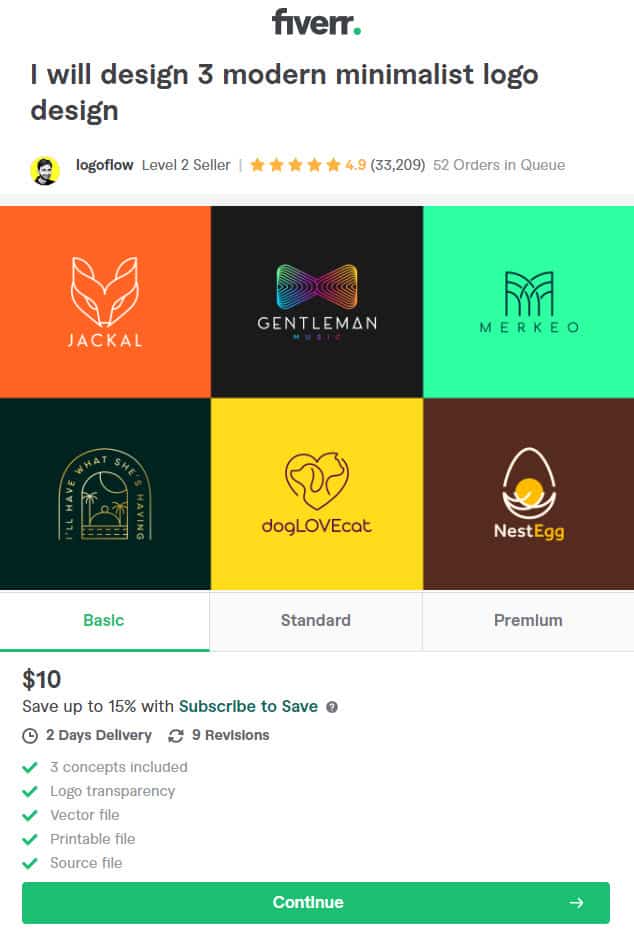
Change Favicon
Favicon is the image that appears in the browser tab and bookmarks. Set the Favicon from the Appearance > Customize section of the WordPress dashboard.

Create Menus
The header and the footer menu can be set from the Appearance > Menus in your WordPress blog dashboard.

You can nest menu items so that it appears as a dropdown menu ❶. You can use the menu as your primary or secondary navigation menu ❷. Don’t forget to save your menu ❸.
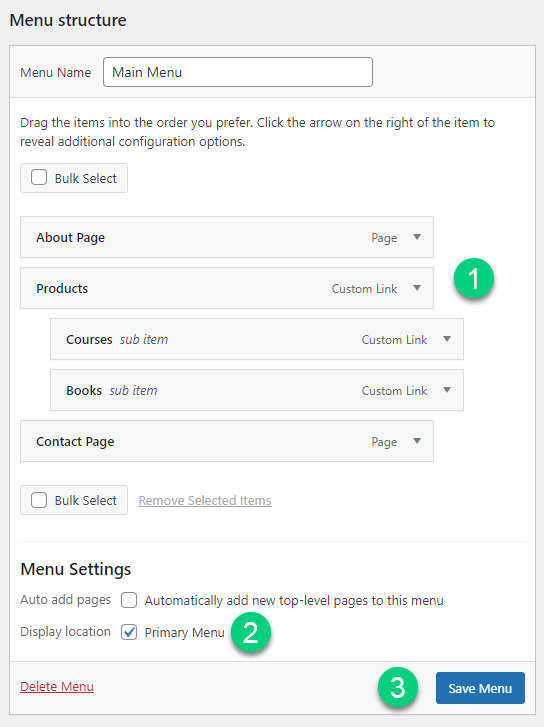
Create Widgets
If you have a sidebar, you can add widgets to it. Go to Appearance > Widgets in your WordPress admin dashboard.
Check out the list of the most useful Blog Widgets and how to add them to your blog.

Set Title & Tag Line
The next step is to change your General Settings. Go to Settings > General in the WordPress Admin area.
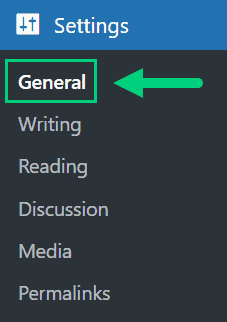
You can set your Site Title, Tagline, and Time Zone from this screen.
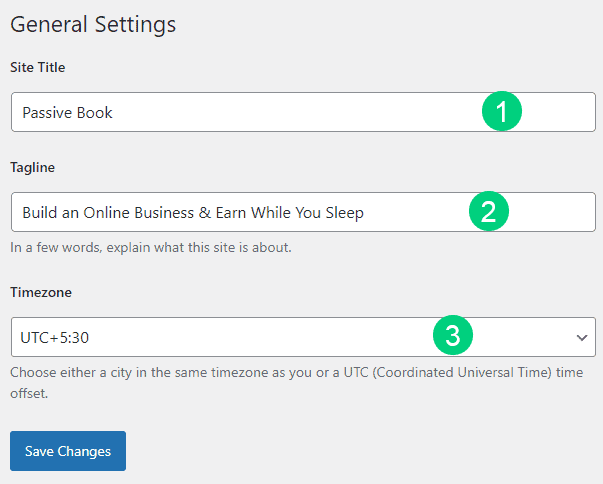
Set Permalinks
The ideal URL structure for SEO is yourdomain.com/sample-post. Set your permalink structure by going to Settings > Permalinks in your WordPress blog dashboard.

Select the “Post name” radio button and save changes.
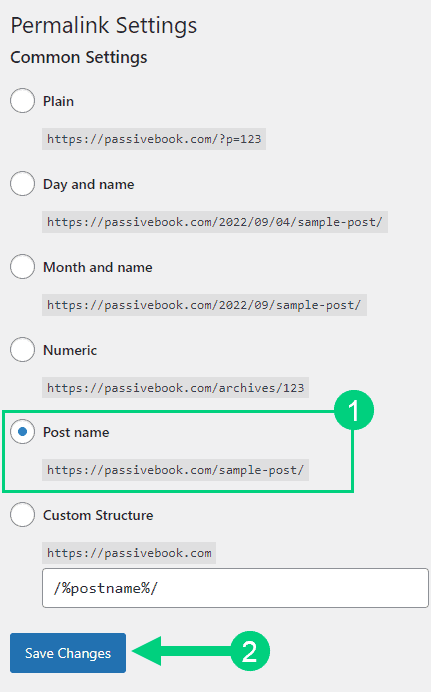
Enable Search Visibility
Chances are you want your blog to show up on Google so people can find you. Go to Settings > Reading in your WordPress dashboard.
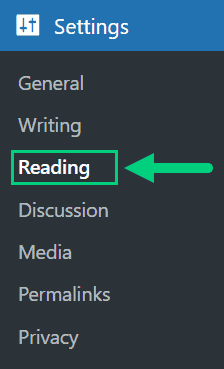
To get search engine traffic, ensure the checkbox “Disable search engines from indexing this site” is Unchecked. You can find this option in Settings > Reading. Most of the time this should be unchecked by default but if it is not, then uncheck it to ensure your site gets traffic from search engines.
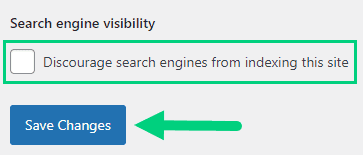
Adjust Comment Settings
Next, you will want to change the Discussion Setting (aka Comments). Go to Settings > Discussion in your WordPress admin area.
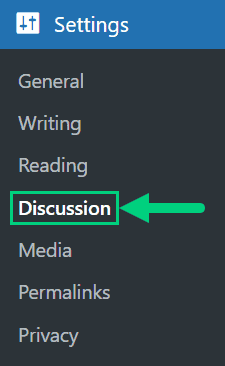
❶ You may want to enable or disable comments on this page. You can also disable pingbacks and enable comment moderation.
❷ You can also set comment approval settings.
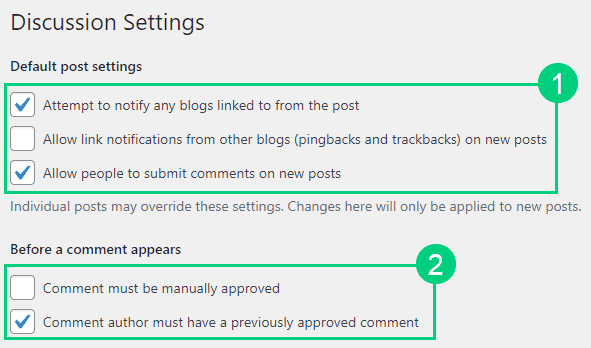
If you want to design your blog further, check out our dedicated guide on blog design which has all our best blog design recommendations.
Create Static Pages
There are a few essential pages that you need to create for your news blog before you can start blogging.
Use pages in WordPress to add static content. Go to WP Dashboard > Pages > Add New.
- Write the headline of your content.
- Populate the body content
- Click the publish button.

You may want to create the following pages:
Home Page
A home page is the main page of your blog. It is the first page that your blog visitors see when they visit your blog. You can use your home page to introduce your blog, tell your blog visitors what you blog about, and showcase your best content.
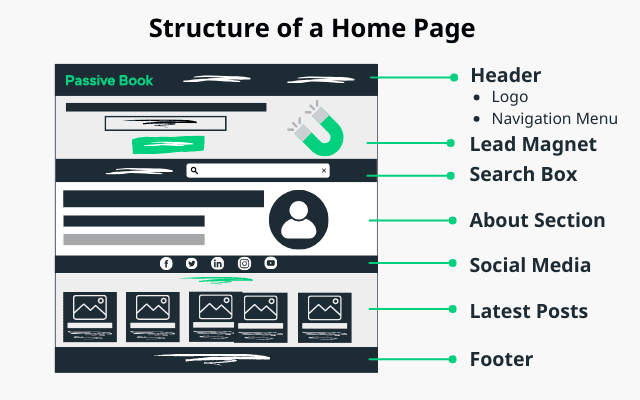
You can create a professional home page for your news blog using a page builder like Thrive Architect.
About Page
An about page is a page on your blog that tells your blog visitors who you are and what you do. It is one of the most important pages on your blog because it helps you to build trust with your blog visitors.

Contact Page
A contact page is a page on your blog where your blog visitors can contact you. It is important to have a contact page on your blog so that your blog visitors can get in touch with you if they have any questions or comments.
Use contact form plugins like Fluent Forms to create the form on your contact page.
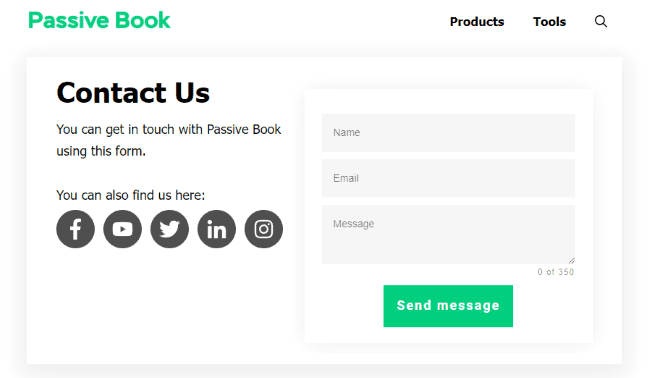
Privacy Policy
A privacy policy page is a page on your blog where you tell your blog visitors how you use their personal data. It is important to have a privacy policy page on your blog if you collect any personal data from your blog visitors.
WordPress generates its own privacy policy for you. But you can also use a tool like Termly to generate your own privacy policy.

Terms of Service
A terms of service page is a page on your blog where you tell your blog visitors the rules that they need to follow when using your blog. It is important to have a terms of service page on your blog so that your blog visitors know what they can and cannot do on your blog.
Use a terms & conditions generator like Termly to create it.
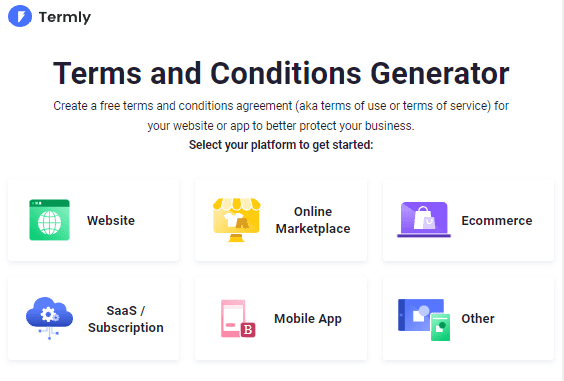
5. Write & Publish Blog Posts
Now that you have your news blog set up, it’s time to write and publish your first blog post.
1. Brainstorm Topics
You should brainstorm 100 topic ideas for your news blog. This will ensure that you always have content to write about in your news blog.
The goal is to find topics for your news blog that your target audience is searching for in Google. The type of content you write on your news blog will depend on your specific niche.
There are a few ways to brainstorm specific content:
Look at Competitors
If you want to be a successful news blogger, you need to be constantly writing new content. But how do you come up with topics to write about?
One way is to look at the articles your competitors are writing about and get inspiration from them.
Competitors can be a great source of inspiration for your blog posts because they have already done the hard work of coming up with topics that are popular in your niche.
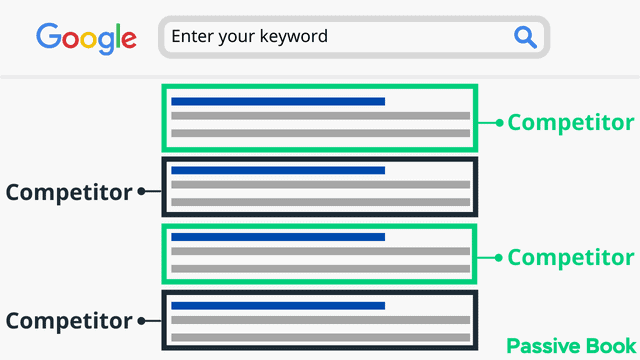
Community & Forums
Another way to find topics to write about for your news blog is to look at the discussions happening in online communities and forums. This can be a great source of inspiration for your blog posts because you can see what topics people are talking about and how they are reacting to them.
You can also participate in these communities and forums and get to know your audience better. This can help you come up with topics that are tailored to their specific needs and interests.
You can also get valuable data on your audience from Facebook Groups, Twitter, and Reddit.
2. Create an Editorial Calendar
An editorial calendar is a tool that helps you plan, organize, and publish your blog posts. It is a valuable tool for news bloggers because it can help you stay on track and make sure that you are always publishing new content.
Some of the benefits of using an editorial calendar are:
- It helps you to plan and organize your blog posts.
- It helps you to stay on track and publish new content regularly.
- It enables you to track your progress and see how your blog is doing.
- It helps you to collaborate with other bloggers and guest writers.
- It helps you to measure the success of your blog posts.
Download Content Calendar Template

Steal our exclusive content calendar template. Have it delivered directly to your inbox:
There are a few different ways to create an editorial calendar. You can use a tool like Google Calendar, Trello, or Asana. Or you can simply create a spreadsheet in Excel or Google Sheets.
3. Write a Blog Post
Now that you have a topic for your first blog post, it’s time to start writing. Check out our in-depth guide on How to Write A Blog Post. Here we will go over specific tips for a news blog.
Breaking News
Breaking News report on recent events as they happen. This type of post is used to inform readers of the latest developments and provide updates on current events.
Some examples of Breaking News post titles include:
- “Breaking News: [Event/Incident/Story]”
- “Latest updates on [Event/Incident/Story]”
- “Developments in [Event/Incident/Story]”

When writing a Breaking News post, it’s important to be accurate and timely in your reporting. Use reliable sources to gather information and verify the facts. Also, it’s important to provide context and background information to help readers understand the significance of the event. Additionally, it can be helpful to include images, videos, or quotes from sources to provide additional perspectives and make the post more engaging.
When writing a breaking news post, it’s also important to consider the tone of your post. While it’s important to be informative, it’s also important to be sensitive to the gravity of the situation and avoid sensationalism or speculation. Also, it’s important to be aware of the ethical considerations of reporting on sensitive issues or events that may affect individuals or communities. Additionally, you need to be aware of the legal considerations and the rights of the individuals involved in the event.
Opinion Pieces
Opinion Pieces express your thoughts and opinions on current events or issues.
Some examples of Opinion Piece post titles include:
- “My thoughts on [Event/Issue]”
- “Why [Event/Issue] matters”
- “The implications of [Event/Issue] for [Group/Country/Industry]”

When writing an opinion piece, it’s important to be clear and well-reasoned in your arguments. Provide evidence and examples to support your opinions. Additionally, it’s important to be aware of multiple perspectives and to address counterarguments in your post. Also, it’s important to be respectful and civil in your tone, even when you disagree with others’ opinions.
It’s also important to be aware of the context of the issue and to provide historical background or current data that can help readers understand the significance of the event or issue. Be aware of the potential impact of your post, and be responsible in your analysis and reporting, considering the consequences of your opinions.
Analysis
The analysis post is a type of blog post where you provide an in-depth analysis of current events and their implications.
Some examples of Analysis post titles include:
- “Deconstructing [Event/Issue]: An Analysis”
- “The Implications of [Event/Issue] for [Group/Country/Industry]”
- “Unpacking the causes and consequences of [Event/Issue]”

When writing an Analysis post, it’s important to be well-informed and well-researched. Provide a thorough overview of the event or issue and its context. Use data, statistics, and expert opinions to support your analysis. Additionally, it’s important to consider the potential impact of the event or issue and to provide recommendations or solutions where appropriate.
When writing an Analysis post, it’s also important to be objective and not overly influenced by any particular bias or agenda. Provide a balanced and fair representation of the facts and consider multiple perspectives.
Investigative Journalism
In investigative journalism you research and report on a specific topic or issue in-depth. This type of post is used to uncover hidden information, expose corruption or injustice, or reveal the truth about a particular event or issue.
Some examples of investigative journalism post titles include:
- “Uncovering the truth behind [Event/Issue]”
- “Investigating [Event/Issue]: The facts behind the headlines”
- “Exposing corruption in [Industry/Organization]”

Use multiple sources and verify the facts. Additionally, it’s important to be aware of the legal and ethical considerations of your reporting and to protect the identities of any confidential sources. It’s also important to be aware of the potential impact of your post and to be responsible in your analysis and reporting, considering the consequences of your findings.
Interviews
Interviews are where you interview experts, sources, or people involved in current events.
Some examples of interview blog post titles include:
- “Interview with [Source/Expert/Person involved in the event]”
- “Conversation with [Source/Expert/Person involved in the event] on [Event/Issue]”

When conducting an interview, it’s important to prepare a list of thoughtful and well-researched questions in advance. Try to ask questions that will elicit interesting and insightful responses, rather than simply asking the interviewee to rehash information that is already known.
It’s also important to be respectful and professional during the interview and to maintain objectivity and impartiality. Additionally, it can be helpful to conduct follow-up research to verify the information provided by the interviewee and to provide context and background information to help readers understand the significance of the interview.
When writing an interview post, it’s also important to be mindful of the tone and language you use and to present the information in a clear, concise, and engaging way. It can be helpful to include quotes or key takeaways from the interview to provide a sense of the interviewee’s perspective and to make the post more interesting for readers. Be sure to get the consent of the interviewee before publishing the post, and to respect their right to privacy or non-disclosure if they have any concerns.
Backgrounders
Backgrounders are a type of blog post where you provide historical context and background information on current events. These posts are designed to help readers understand the significance of an event or issue by providing a broader historical perspective.
Some examples of backgrounder post titles include:
- “The history behind [Event/Issue]”
- “Understanding [Event/Issue] in context”
- “A historical perspective on [Event/Issue]”

Provide a thorough overview of the historical context of the event or issue and use reliable sources to support your analysis.
It’s also important to consider the current relevance of the historical context for the readers and to provide a clear link between the historical context and the current event or issue.
Live Blogging
In a live blogging post you provide real-time updates and coverage of an event as it happens.
Some examples of Live Blogging post titles include:
- “Live coverage of [Event]”
- “Updates from [Event]”
- “Real-time reporting on [Event]”

When live blogging, it’s important to be accurate and timely in your reporting. Provide updates as they happen, and include images, videos, or quotes from sources to provide additional perspectives and make the post more engaging.
Additionally, it can be helpful to include a summary or a recap of the event at the end of the live blog post, for those who may not have been able to follow the live updates. Also, consider the use of multimedia elements, such as images and videos to enhance the coverage and make it more engaging for the readers.
Fact-checking
In a fact-checking post you verify the accuracy of news stories and statements made by public figures.
Some examples of Fact-checking post titles include:
- “Fact-checking [Claim/statement]”
- “The truth behind [Claim/statement]”
- “Verifying the accuracy of [Claim/statement]”

Use multiple sources and verify the facts. Also, be transparent about your fact-checking process, and provide links to the sources used for verification so that readers can verify the information for themselves.
Predictions
Predictions post use data and analysis to make predictions about future events.
Some examples of Prediction post titles include:
- “What to expect in [Industry/Field] in the future”
- “Future projections for [Event/Issue]”
- “Trend analysis and predictions for [Event/Issue]”

When making predictions, it’s important to be well-informed and well-researched. Use data, statistics, and expert opinions to support your predictions. Consider the potential impact of the event and provide recommendations or solutions where appropriate.
General Tips for Writing News
Before we get into specific types of news posts, here are some helpful tips:
Write for your audience
When you’re writing a new blog post, it’s important to keep your audience in mind. Write for them and not for yourself.
Think about what they want to read and how you can help them. Keep your posts focused on their needs and interests.
Establish the Four Main Ws
Every news blog post should have the four main Ws: who, what, when, and where.
Who is the audience you are writing for? What is the topic of your blog post? When is the time frame in which your blog post will be relevant? And where is the location of your blog post?
For example, if you’re writing a blog post about a new restaurant that just opened up in your city, the four main Ws would be:
- Who – people who live in your city
- What – a new restaurant that just opened up
- When – now
- Where – your city
These four Ws will help you to focus your blog post and make sure that it is relevant to your audience.
Research additional facts and figures
If you want your blog post to be credible, you need to back it up with facts and figures. Research additional information on your topic and include it in your blog post.
Cite your sources
Whenever you use someone else’s information in your blog post, make sure to cite your sources. This will help to make your blog post more credible and trustworthy.
Write 5x Faster With AI
You can write your new blog post at 5x speed using the AI writing software Jasper. I was able to write over a hundred blog articles in 3 months using Jasper. This blog article you are reading right now was written with the help of Jasper. AI will not only help you write blog posts fast but also with higher quality.
Jasper can write plagiarism-free blog content, articles, social media content, emails, and ad copy. All you have to do is provide a few inputs on what you want and Jasper will do all the hard work of creating the blog content for you. No more writer’s block.
Check out the video below to see Jasper in action:
Try Jasper for free using the links on this page and get 10,000 bonus credits you can use to start writing your first articles.
Once you sign up for Jasper I recommend you spend some time going through the tutorial videos in the Jasper Bootcamp to truly unlock the power of this amazing software.
Check out our guide on How to Write a Blog Post Fast in 15 mins Without Losing Quality for more tips to write fast.
Outsource Writing
If you don’t have the time or energy to write a blog post, you can always outsource to writing services. Many freelance writers would be happy to write a blog post for you.
You can find freelance writers on sites like Fiverr, Upwork, and Freelancer.

4. Add Images
Images are a great way to break up your text and make your blog posts more visually appealing. They can also help you to illustrate your points and make your posts more shareable on social media.
When you’re adding images to your blog posts, make sure that you use high-quality images that are relevant to the topic of your post.
The best photos are the ones you take yourself. This is because you have complete control over the photo and you can make sure that it is high quality. You also have the opportunity to capture the moment in a way that no one else can.
When you’re taking photos for your blog, it’s important to use high-quality equipment. This will help to ensure that your photos look good.
You should also try to take photos in different locations and settings. This will help to make your blog posts more visually appealing.
When adding images to your blog posts, you can also use stock images. Stock images are photos that are available for purchase and use online.
There are many sites where you can find stock images:
Free Options: Pixabay, Pexels, Upsplash
Paid Options: Deposit Photos, Shutterstock, iStock, Getty Images, 123rf.
Canva is a free online design tool that allows you to create professional-looking images. It’s easy to use and it has a wide variety of templates and tools. You can use Canva to create images for your blog posts, social media posts, and email newsletters.
Canva Pro offers a free library of stock images that you can use in your blog posts, social media posts, and email newsletters. The images are high quality and they are all licensed for commercial use. If you upgrade to Canva Pro, it will give you all the stock photography that you will ever need.
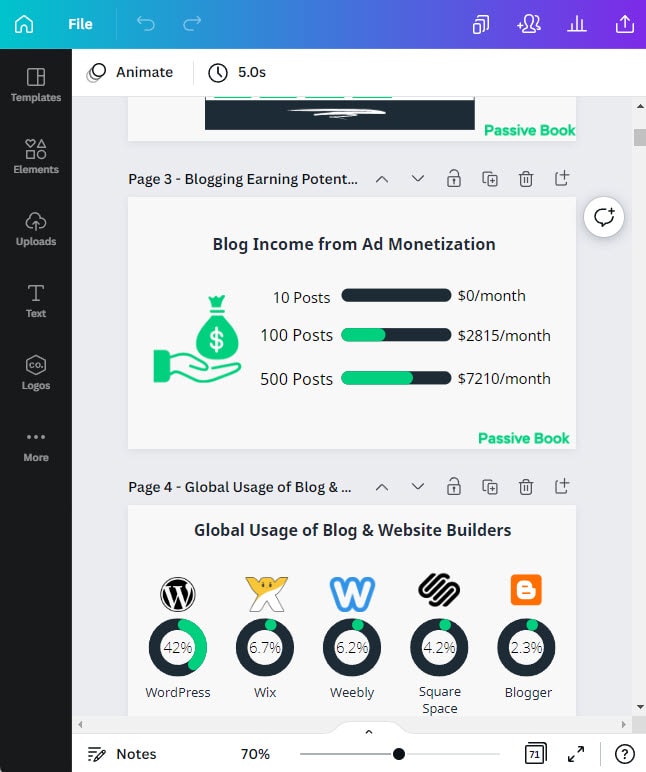
6. Promote Your News Blog
There are many ways that you can promote your blog posts. Here are some of the most effective methods:
Search Engine Optimization (SEO)
SEO, or search engine optimization, is the process of optimizing your blog so that it ranks higher in search engine results pages. When people search for a topic online, they will likely use a keyword or phrase. If your blog ranks high on the results pages for that keyword or phrase, you will get more traffic to your blog.
There are many different aspects of SEO that you can optimize, including your blog title, meta descriptions, header tags, and images. You can also improve your blog’s speed and usability.
Many factors go into SEO, and it can be a bit confusing to figure out where to start. You can master the more advanced SEO tactics by checking out our SEO Resources.
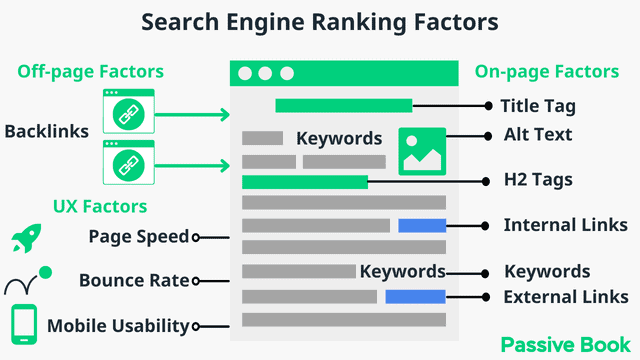
You can ensure you get the basics of SEO right, by completing the recommendations given by the RankMath plugin.
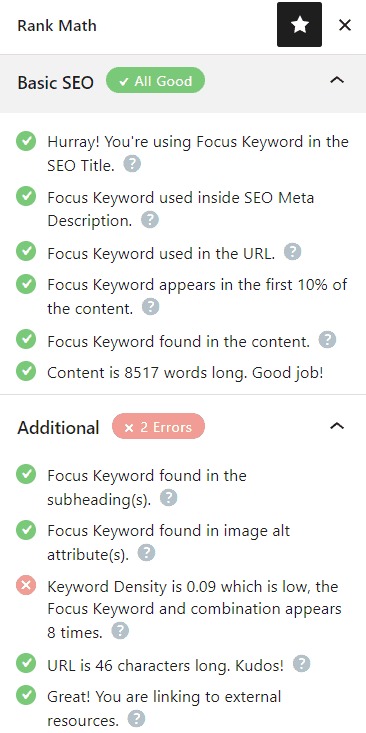
Rank Math also helps you generate a Google News Sitemap that will make your blog appear in Google News. Google News is a news aggregator that will help you get additional traffic.
Email Marketing
Email marketing is a great way to promote your blog posts to a wider audience. You can send out an email to your subscribers with a link to your latest blog post.
To get started with email marketing, you need to first build a list of subscribers. You need to create opt-in forms to collect email addresses and then connect them with an email marketing service to send emails and manage your subscribers.
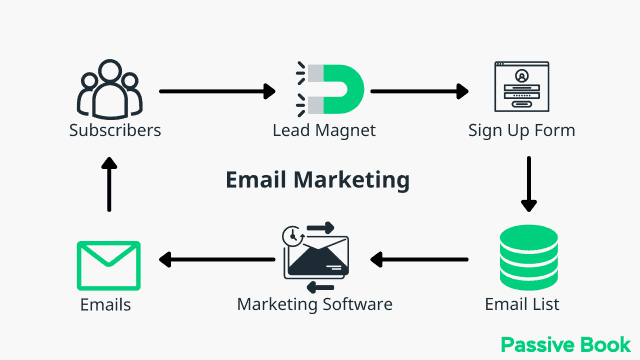
You can use the Thrive Leads plugin to build opt-in forms to collect email addresses. You can then connect the opt-in form to an email marketing service like Active Campaign to send out the emails.
Check out our Email Marketing resources to learn more.
Social Media Marketing
Social media marketing is a great way to promote your blog posts and drive traffic to your blog. You can share your blog post on social media platforms like Facebook, Twitter, and LinkedIn.
When sharing your blog post on social media, make sure to use an engaging headline and eye-catching images. You should also add a call-to-action (CTA) so that people know what you want them to do next.
Guest blogging
Guest blogging is a great way to get your blog in front of a new audience. When you guest blog, you write a blog post for another person’s blog.
This is a great way to build relationships with other bloggers in your industry and to get your name out there. It can also help you to drive traffic to your blog.
When looking for guest blogging opportunities, make sure to find blogs that are relevant to your niche and have a good reputation. You should also make sure that the blog has a high domain authority so that your blog post will be more likely to rank high in search engine results.
You can link back to your blog from the guest post. You can also promote your blog from your author bio.
7. Monetize & Make Money
There are a few different ways that you can make money from your news blog.
Advertising
One way to make money from your blog is through advertising. You can sell ad space on your blog and get paid whenever someone views your ad.
You need to sign up for an ad network. Once you are approved, you can start placing ads on your blog. Ad networks will provide you with a code to insert into your blog. Once the code is inserted, the ad network will serve the ads on your blog.
To start advertising on your blog, you can sign up for an ad network like Ezoic (they pay more than Google Adsense). When your blog starts getting more than 100,000 page views a month you can monetize with Adthrive.
| Ad Network | Earnings Per 1K Impressions (EPM) | Monthly Traffic Requirement |
|---|---|---|
| Ad Thrive | $13 | 100,000 |
| Ezoic | $3 | 10,000 |
| Media.net | $1 | – |
| Google Adsense | $1 | – |
Affiliate marketing
Another way that you can make money from your blog is through affiliate marketing. With affiliate marketing, you promote someone else’s product or service on your blog and get paid a commission whenever someone buys the product or signs up for the service using your affiliate links.
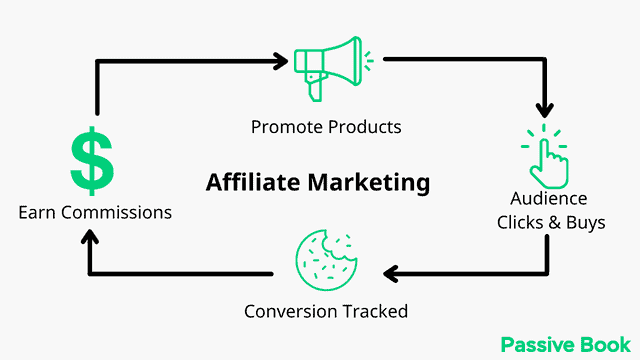
To find affiliate programs, you can search for “affiliate program + niche”. For example, if you are in the fitness niche, you can search for “fitness affiliate programs”.
You can then sign up for the affiliate program and start promoting the products or services on your blog.
Sell digital products
If you have expertise in a particular area, you can create and sell digital products like eBooks, online courses, and webinars.
This is a great way to monetize your blog as it allows you to share your knowledge with others and get paid for it.
To get started with selling digital products, you need to first create the product. Once you have created the product, you can then sell it on your blog.
You can use Teachable if you want to sell video courses. Your students will have a dedicated course members area and a community system to ask questions and interact with each other. If you only want to sell eBooks, you can use SendOwl which lets you sell your digital products and eBooks for free.

Sponsored Posts
You can also make money from your blog by writing sponsored posts. A sponsored post is a blog post that is written by someone who has been paid to write it.

The sponsor will usually provide you with a list of topics that they would like you to cover in the blog post.
Once you have written the blog post, you can then publish it on your blog.
FAQ
How do you write a good news blog?
To write a good news blog, you need to have passion for the topic that you are writing about. You should also be able to engage with your audience and write in a way that is easy to understand. It is also important to make sure that your blog posts are well-researched and accurate.
How do I start a news blog u0026amp; make money online?
There are a few different ways that you can make money from your news blog. Advertising, affiliate marketing, selling digital products, and sponsored posts are all great ways to monetize your blog. To get started, you need to choose a niche and register a domain name. Once you have set up your blog, you can then start writing blog posts and promoting them.
Can I make money from a news blog?
Yes, you can make money from a news blog. There are a few different ways that you can monetize your blog, such as advertising, affiliate marketing, selling digital products, and sponsored posts. To get started, you need to choose a niche and register a domain name. Once you have set up your blog, you can then start writing blog posts and promoting them.
What Next?
Starting your own news blog is one of the most rewarding but challenging experiences.
Keep in mind that it takes hard work and dedication to succeed in the world of online journalism. But with perseverance, you can create a successful news blog that engages readers and tells important stories.
We hope this guide showed you how to start a news blog. If you have any questions as you set up your new blog, leave a comment below so we can help you out.
Have you started your news blog yet? What type of news blog are you going to start? Let us know in the comments.
Share this post with your friends & followers:
